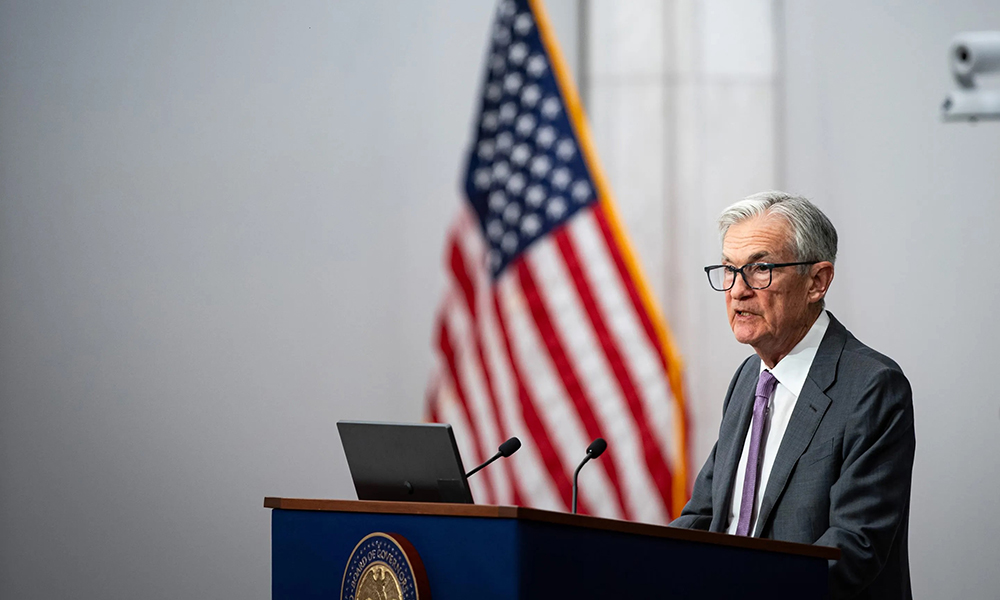
随着美联储(Federal Reserve)官员释放出维持利率不变的长期信号,投资者和经济学家本周将密切关注美联储主席杰罗姆·鲍威尔,希望从他身上找到一些蛛丝马迹,判断可能最终促使央行采取行动的因素以及行动时机。
美联储连续四次会议维持利率不变,可能再次招致唐纳德·特朗普总统的猛烈抨击。但政策制定者们已明确表示:在采取行动之前,他们需要白宫解决关税、移民和税收等重大问题。以色列对伊朗核设施的袭击也给全球经济带来了另一个不确定因素。
与此同时,美国经济总体健康,或许正在缓慢降温,几乎没有人预期近期会有利率变动。根据期货合约定价,投资者押注美联储最早也要到9月份才会下调借贷成本。
信安资产管理公司(Principal Asset Management)首席全球策略师西玛·沙阿表示:“在当前没有降息紧迫性的情况下,最稳妥的做法就是按兵不动。”
艰难抉择
人们普遍预期,美国总统特朗普的关税政策将推高物价并抑制增长,美联储官员在上次会后声明中指出了这些风险。这最终可能迫使美联储在经济形势让官员们左右为难之际做出艰难抉择。
资本集团(Capital Group)固定收益投资组合经理大卫·霍格表示:“我认为目前还无需担忧。但这种不确定性持续得越久——无论是对消费者,还是对企业的规划而言——我就越担心经济基本面会恶化。”
然而,迄今为止,美国经济并未发出会促使美联储出手干预的警示信号。
尽管就业增长放缓,失业率仍连续三个月保持稳定,部分原因是移民人数锐减减少了劳动力供给。失业率保持稳定的时间越长,美联储就能将利率维持在高位越久,以此作为应对潜在通胀上升的手段。
物价数据也并未出现令人担忧的迹象。5月份核心通胀连续第四个月涨幅低于预期。上周,受此消息提振,再加上市场押注今年将不止一次降息,美国国债上涨。对美联储政策最敏感的两年期国债收益率当周下跌逾7个基点,降至3.96%。
尽管如此,美联储官员可能仍需等待未来数月的数据,以了解有多少关税成本转嫁给了消费者。以色列对伊朗的空袭将带来更多疑问。美联储官员通常会忽略能源价格的波动,但油价飙升可能会影响通胀预期。
最新预测
本周出炉的最新经济预测和利率预测有望为了解官员们的想法提供有效指引。这将是自特朗普于4月2日“解放日”宣布全面加征关税以来的首次预测更新。
分析师们思考预测结果时发现,可能性范围异常之大。
沙阿表示,如果美联储官员们预测今年失业率将显著高于3月份预测的4.4%,则表明政策制定者可能在第四季度之前降息。
包括理事克里斯托弗·沃勒在内的一些美联储官员已经表示对降息持开放态度,因为他们认为只要通胀预期保持稳定,政策制定者可以将关税对消费者价格的预期影响视为暂时影响。这与基于市场的指标一致。市场指标表明交易员也认为关税引发的价格上涨将是短暂的。
但德意志银行(Deutsche Bank)美国首席经济学家马修·卢泽蒂表示,如果美联储官员上调通胀预期,可能将他们预测的今年降息次数从3月份预测的两次减少到一次。巴克莱(Barclays)的策略师在给客户的一份报告中警告称,美联储可能会出现这种“鹰派”的意外举动。
美联储官员们也可能会考虑到特朗普政策最终形态的巨大不确定性,从而干脆维持其预测不变。
CreditSights投资级和宏观经济策略主管扎卡里·格里菲斯表示:“如果点阵图变动很大,我会感到惊讶。”自美联储3月份发布上次预测以来,“形势如同过山车一样”。他表示:“总的来说,我认为我们可能正处于一种大致相似的局面。”
迟来的支持
一些经济学家表示,美联储下一步行动的时机最终将取决于特朗普的政策需要多长时间才会体现在经济数据中,以及这些数据引发的对经济衰退的担忧有多强烈。
在彭博社6月6日至11日进行的经济学家调查中,42%的受访者预测美联储将维持利率不变,直到经济出现更具体的疲软迹象。
研究机构MacroPolicy Perspectives的创始人、前美联储经济学家朱莉娅·科罗纳多表示,她预计降息将在10月或12月开始,以应对她估计届时将出现的更为显著的劳动力市场放缓。(财富中文网)
译者:刘进龙
审校:汪皓
随着美联储(Federal Reserve)官员释放出维持利率不变的长期信号,投资者和经济学家本周将密切关注美联储主席杰罗姆·鲍威尔,希望从他身上找到一些蛛丝马迹,判断可能最终促使央行采取行动的因素以及行动时机。
美联储连续四次会议维持利率不变,可能再次招致唐纳德·特朗普总统的猛烈抨击。但政策制定者们已明确表示:在采取行动之前,他们需要白宫解决关税、移民和税收等重大问题。以色列对伊朗核设施的袭击也给全球经济带来了另一个不确定因素。
与此同时,美国经济总体健康,或许正在缓慢降温,几乎没有人预期近期会有利率变动。根据期货合约定价,投资者押注美联储最早也要到9月份才会下调借贷成本。
信安资产管理公司(Principal Asset Management)首席全球策略师西玛·沙阿表示:“在当前没有降息紧迫性的情况下,最稳妥的做法就是按兵不动。”
艰难抉择
人们普遍预期,美国总统特朗普的关税政策将推高物价并抑制增长,美联储官员在上次会后声明中指出了这些风险。这最终可能迫使美联储在经济形势让官员们左右为难之际做出艰难抉择。
资本集团(Capital Group)固定收益投资组合经理大卫·霍格表示:“我认为目前还无需担忧。但这种不确定性持续得越久——无论是对消费者,还是对企业的规划而言——我就越担心经济基本面会恶化。”
然而,迄今为止,美国经济并未发出会促使美联储出手干预的警示信号。
尽管就业增长放缓,失业率仍连续三个月保持稳定,部分原因是移民人数锐减减少了劳动力供给。失业率保持稳定的时间越长,美联储就能将利率维持在高位越久,以此作为应对潜在通胀上升的手段。
物价数据也并未出现令人担忧的迹象。5月份核心通胀连续第四个月涨幅低于预期。上周,受此消息提振,再加上市场押注今年将不止一次降息,美国国债上涨。对美联储政策最敏感的两年期国债收益率当周下跌逾7个基点,降至3.96%。
尽管如此,美联储官员可能仍需等待未来数月的数据,以了解有多少关税成本转嫁给了消费者。以色列对伊朗的空袭将带来更多疑问。美联储官员通常会忽略能源价格的波动,但油价飙升可能会影响通胀预期。
最新预测
本周出炉的最新经济预测和利率预测有望为了解官员们的想法提供有效指引。这将是自特朗普于4月2日“解放日”宣布全面加征关税以来的首次预测更新。
分析师们思考预测结果时发现,可能性范围异常之大。
沙阿表示,如果美联储官员们预测今年失业率将显著高于3月份预测的4.4%,则表明政策制定者可能在第四季度之前降息。
包括理事克里斯托弗·沃勒在内的一些美联储官员已经表示对降息持开放态度,因为他们认为只要通胀预期保持稳定,政策制定者可以将关税对消费者价格的预期影响视为暂时影响。这与基于市场的指标一致。市场指标表明交易员也认为关税引发的价格上涨将是短暂的。
但德意志银行(Deutsche Bank)美国首席经济学家马修·卢泽蒂表示,如果美联储官员上调通胀预期,可能将他们预测的今年降息次数从3月份预测的两次减少到一次。巴克莱(Barclays)的策略师在给客户的一份报告中警告称,美联储可能会出现这种“鹰派”的意外举动。
美联储官员们也可能会考虑到特朗普政策最终形态的巨大不确定性,从而干脆维持其预测不变。
CreditSights投资级和宏观经济策略主管扎卡里·格里菲斯表示:“如果点阵图变动很大,我会感到惊讶。”自美联储3月份发布上次预测以来,“形势如同过山车一样”。他表示:“总的来说,我认为我们可能正处于一种大致相似的局面。”
迟来的支持
一些经济学家表示,美联储下一步行动的时机最终将取决于特朗普的政策需要多长时间才会体现在经济数据中,以及这些数据引发的对经济衰退的担忧有多强烈。
在彭博社6月6日至11日进行的经济学家调查中,42%的受访者预测美联储将维持利率不变,直到经济出现更具体的疲软迹象。
研究机构MacroPolicy Perspectives的创始人、前美联储经济学家朱莉娅·科罗纳多表示,她预计降息将在10月或12月开始,以应对她估计届时将出现的更为显著的劳动力市场放缓。(财富中文网)
译者:刘进龙
审校:汪皓
With Federal Reserve officials signaling an extended hold on interest rates, investors and economists will look to Chair Jerome Powell this week for clues on what might eventually prompt the central bank to make a move, and when.
A fourth straight meeting without a cut could provoke another tirade from President Donald Trump. But policymakers have been clear: Before they can make a move they need the White House to resolve the big question marks around tariffs, immigration and taxes. Israel’s attacks on Iranian nuclear sites have also introduced another element of uncertainty for the global economy.
At the same time, the generally healthy, if slowly cooling, US economy has few expecting a rate move any time soon. Investors are betting the central bank won’t lower borrowing costs until September at the earliest, according to pricing in futures contracts.
“The safest path to take in that situation, when there is no urgency to cut rates right now, is to just sit on your hands,” said Seema Shah, chief global strategist at Principal Asset Management.
Difficult Choices
The president’s tariffs are widely expected to raise prices and slow growth, risks that officials flagged in their last post-meeting statement. That could eventually force the Fed to make a difficult choice as the economy pulls them in opposite directions.
“I don’t think at this point there’s anything to be alarmed about,” said David Hoag, fixed income portfolio manager at Capital Group. “But the longer we have uncertainty — for the consumer, for companies in terms of planning — the more concerned I’ll get about the fundamentals of the economy deteriorating.”
So far, however, the economy isn’t flashing warning signs that would prompt the Fed to intervene.
The unemployment rate has held steady for three months even as job growth has slowed, in part because a sharp decline in immigration is also lowering the supply of workers. The longer the jobless rate remains stable, the longer the Fed can hold rates as a defense against potentially higher inflation.
Yet price data has also provided little to worry about. Underlying inflation rose by less than expected in May for the fourth straight month. Treasuries rose last week on the news, bolstered by wagers on more than one rate cut this year. The yield on two-year notes, most sensitive to the Fed’s policy, declined by more than seven basis points on the week to 3.96%.
Still, officials are likely to wait for additional months of data to understand how much of the tariffs are being passed on to consumers. Israel’s airstrikes on Iran will raise additional questions. Fed officials traditionally look through energy price moves, but an oil price shock could affect inflation expectations.
Fresh Projections
Fresh economic forecasts and rate projections this week could provide helpful guidance to how officials are thinking. They’ll be the first since Trump’s “Liberation Day” announcement of sweeping tariffs on April 2.
As analysts ponder the results, the range of possibilities is unusually large.
If officials predict that unemployment will rise this year meaningfully above the 4.4% they forecast in March, that would suggest policymakers may cut rates before the fourth quarter, said Shah.
Some Fed officials, including Governor Christopher Waller, have already signaled an openness to cutting because they believe policymakers can view the expected impact of tariffs on consumer prices as temporary — as long as inflation expectations remain anchored. That aligns with market-based measures suggesting traders also believe the tariff price bump will be short-lived.
But should officials raise their expectations for inflation, that could reduce the number of cuts they project this year to one, from the two seen in March, said Matthew Luzzetti, chief US economist for Deutsche Bank. Strategists at Barclays warned of just such a “hawkish” surprise in a note to clients.
Officials might also consider the substantial uncertainty over the final state of Trump’s policies and simply leave their projections unchanged.
“I’d be surprised if the dots move much,” said Zachary Griffiths head of investment-grade and macroeconomic strategy at CreditSights. “It’s been a roller-coaster ride” since the Fed last released projections in March. “On net, I think we’re probably in a somewhat similar situation,” he said.
Late Support
Some economists say the timing of the Fed’s next moves will eventually come down to how long it takes for Trump’s policies to show up in the economic data — and how strongly that raises concerns about a downturn.
In a Bloomberg survey of economists conducted June 6-11, 42% of respondents predicted the Fed will hold rates steady until there’s more concrete weakness in the economy.
Julia Coronado, founder of the research firm MacroPolicy Perspectives and a former Fed economist, said she expects rate cuts beginning in October or December in response to the more notable labor-market slowdown she estimates will materialize by then.






